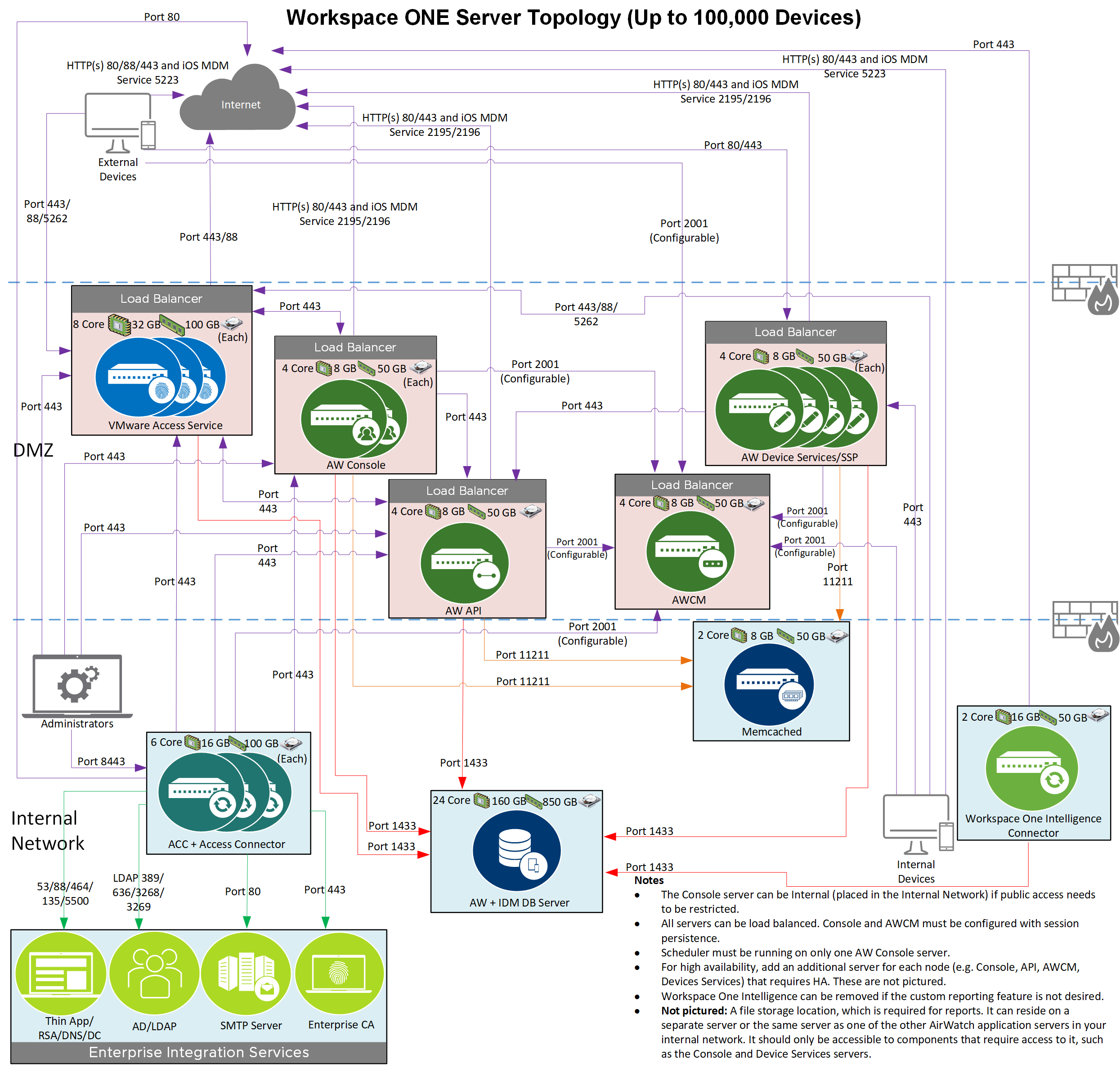Determining the recommended architecture sizing for your network infrastructure is essential to receiving and maintaining optimal performance. Learn more about how sizing requirements for servers, consoles, and componenets for deployments of more than 50,000 devices, and up to 100,000.
Use the table to determine the sizing requirements for a deployment of more than 50,000 devices. Each column represents the requirements for a deployment up to that number of devices. The columns are not cumulative – each column contains the exact requirements for the listed number of devices.
Consider the following figures as starting points. You may need to adjust them as you implement different features of the Workspace ONE UEM solution. Transaction frequency, number of concurrent connections, and other metrics affect performance, and you might need to tweak the numbers to accommodate your specific deployment. Contact Workspace ONE support if you require extra assistance.
Additional notes to consider:
- If your deployment uses a shared database, you must ensure that the database optimizations in this guide do not adversely affect the other running DB instances. If you cannot ensure this, use a dedicated DB server.
- Certain SQL versions have a maximum supported RAM limit, so review your SQL version's RAM limitation to ensure that all hardware functions as intended.
- Load balancing for application servers is provided by the customer.
- The file storage requirement for reports can affect the amount of hard disk space needed on the Console and Device Services servers, depending on whether you enable caching. See Reports Storage Requirements for more information.
| Server |
Up to 100,000 Devices |
|
|---|---|---|
| Database server |
CPU Cores |
16 cores |
| RAM (GB) |
128 |
|
| DB Size (GB) |
750 |
|
| Trans Log Size (GB) (Log backups every 15 minutes) |
400 |
|
| Temp DB (GB) |
300 |
|
| Avg IOPS (DB & Temp DB) |
2,000 |
|
| Peak IOPS (DB & Temp DB) |
6,000 |
|
| UEM console (dedicated) |
2 load-balanced application servers, each with: 8 GB RAM, 4 CPU Cores, and 50 GB storage |
|
| API Server (dedicated)** |
1 application server with 4 CPU cores, 8 GB RAM, and 50 GB storage |
|
| Device Services (dedicated) |
4 load-balanced application servers, each with: 8 GB RAM, 4 CPU Cores, and 50 GB storage |
|
| AWCM Server (dedicated) |
1 application server with 4 CPU cores, 8 GB RAM, and 50 GB storage |
|
| AWCM Server (Dedicated with 40K+ Windows 10 or Android devices) |
Each AWCM server must have 8 CPU and 8GB RAM per 40,000 devices and active connections. For example, 120,000 Android Devices requires 3 servers with 8CPU and 8GB RAM each. |
|
| VMware Workspace ONE Access |
||
| Workspace ONE Access Connector |
||
| VMware AirWatch Cloud Connector |
||
| SEG Proxy Server |
||
| VMware Tunnel |
See VMware Tunnel and Unified Content Gateway (Tunnel) Hardware Sizing |
|
| Email Notification Service |
||
| Content Gateway |
See AirWatch Content Gateway and Unified Access Gateway (Content Gateway) Hardware Sizing |
|
| Workspace ONE Intelligence |
||
| Adaptiva |
See Adaptiva |
|
| Memcached |
See Memcached |
|
| Airlift |
||
| Dell Factory Provisioning |
** If your API server is standalone then the network requirements for the API server is to ensure connectivity to the database and various cloud messaging platforms (APNS, FCM, WNS) over ports 80, 443, 2195, and 2196. All other Workspace ONE UEM services (Console, Device Services, SEG, VMware Tunnel) must be enabled to communicate to the API server over HTTPS (443).
